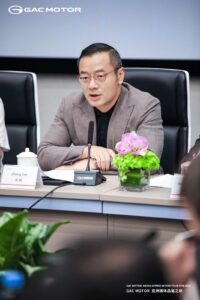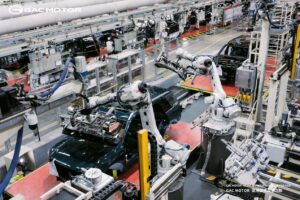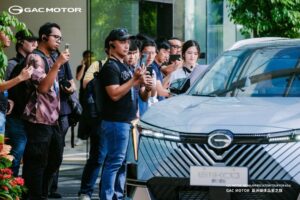This is where esteemed GAC Chief Designer sees the brand in the next 5 years
The media appreciation tour of GAC’s vast advanced technology and craftsmanship in Guangzhou, China left nothing but “oohs” and “ahhs” from the mouths of the Filipino journalists who were part of the four-day trip, including this writer. It was an eye-opener, to say the least, of how far this Chinese carmaker has already gone in the four-wheeled world since its inception about 15 years ago.
Indeed, GAC Motor or Guangzhou Automobile Group Motor Co., Ltd. has grown exponentially, by leaps and bounds (emphasizing this even more just to reiterate how awestruck this writer really was of how much the company has achieved in just a short span of time.)
Think of this, China barely had four-wheeled vehicles plying its roads 30 years ago. Or its local cars were actually generally rebadged versions of other car brands from Japan and the US, a popular practice that continued up to about a decade ago.
Now, just look at them. GAC Motor with the Aion brand under its wing, for one, is now the third biggest electric vehicle maker in the world. For starters, Aion is the company’s premium full electric vehicle arm.
And it doesn’t stop there. What really blew my mind was the straight up one-word “poker face” reply of the company’s chief designer and vice president, Zhang Fan, to one of our colleague’s questions during a panel interview in one of the company’s sprawling facilities in Guangzhou.
“Everywhere,” he averred, when asked how he sees the brand in the next five years.
True enough, the statement is in line with the company’s direction it aspires to in the next decade which it dubbed: “Trillion GAC 1578 Development Outline.” Meaning, the plan focuses on 1 goal, 5 areas, 7 segments and 8 actions.
Basically, according to the plan, the company is to produce and sell vehicles that would exceed 4.75 million units and reach RMB 1 trillion (USD 145.16 billion) in revenue by 2030. GAC plans to do this through strengthening supply chains, building an energy ecosystem, and upgrading current models with ‘intelligent technologies.’
In 2022, the GAC Group churned out 2.4 million units despite the brunt of the pandemic, extended chip shortage and rising raw material prices. GAC Motor and Aion products, meanwhile, achieved total production and sales of more than 620,000 vehicles in China, of which 43 percent were New Energy Vehicles.
For one, Aion’s homegrown bestselling models: The Y Plus and S Plus sell monthly averages of 20,000 units and 26,000 units, respectively.



Intelligent technologies
During the tour, we were able to visit the GAC Technology Museum and just awed at the various technological innovations. The 7,800-sqm museum consisted of the company’s years of pioneering advancements in intelligence and electrification. It also serves as a hub for customer service, product exhibition and sales service.
There, the halls were divided into six sections: Power, new energy, intelligence and connectivity, sustainability and future orientation.
Various prototypes were also presented particularly its “flying car,” GOVE (Guangzhou Automobile Group on-the-go vertical flight electrical vehicle), a single-seater vehicle with six sets of rotor blades connected to a detachable drone body.
Next, the high-density NCM lithium-ion battery-powered Aion Hyper SSR was also there. It can go from 0- 100kph in just 1.9 seconds and has 1,225 horsepower. It will be the carmaker’s first production two-door coupe.
Other technologies on display include: Advanced hydrogen systems, fuel cell electric vehicles, Carbon Fiber Rotor Motor, EV chargers, advanced driver assist systems and many more.
Sprawling factories, together with research and development centers
From museum tours, we headed to factories and visited GAC’s research and development centers.
The highlight of the company’s factories would particularly be their number of artificial intelligence components in the area. Here, a big chunk of segments are automated and have, in turn, saved them an instrumental percentage of money and manpower. We’ve seen robots doing stamping, welding, assembling, painting and particularly the “nitty gritty” parts of vehicle manufacturing. Unlike manual labor, these machines have better memory, sharper, faster, have higher precision and keep errors at bay. According to them, these robotics have allowed them to save 30 percent of their factory costs. For example, at the windshield laying, the machines there have already replaced two manual operators.
On the other hand, the 500,000-square meter R&D area facility located in the Panyu District of Guangzhou has countless of scientists and engineers working on new innovations and technologies.
Fan said, “The Chinese automotive market has been very competitive. We have to continuously evolve, innovate, and invent newer, faster and better technologies than before. As much as possible, we want to be at the forefront.”
In fact, according to him, GAC is investing 30 billion yuan (around P233 billion) to further expand and better its R&D facilities in the next five years.
So far, its R&D facilities have expanded to the United States and Europe.
With what we have seen, there is–indeed–infinite more possibilities for this Chinese brand. Behind these magnificent structures are the men and women who have the same discipline, work ethic, belief and mentality that tirelessly drive them further to new heights.
GAC’s slogan may mean “Go and Change.” But, so far, from what we have seen and the enormous potential that lies ahead for the brand, I say to them: GAC, ‘Go And Chase’ your trillions!









